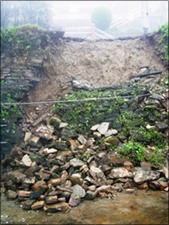Himalayan flood toll 150 and rising; fresh landslide in Almora
20 Jun 2013
As rescue operations gather momentum after the devastating floods and resultant landslides in the mountain areas of north India – with Uttarakhand state by far the worst hit – a fresh heavy landslide was reported in Almora district this morning (See: Floods wreak havoc over large parts of Uttarakhand).
 Entire roads have caved in or been washed away. Repair work is under way and authorities are attempting to clear the rubble.
Entire roads have caved in or been washed away. Repair work is under way and authorities are attempting to clear the rubble.
The death toll from the floods now officially stands at 150, and is expected to rise.
The road to and from the devastated pilgrimage shrine of Kedarnath to Uttarkashi has reopened and thousands of tourists who were stranded are now on their way out.
Rudraprayag Superintendent of Police Nilesh Anand Bharne said that over 1,000 people have been brought to Guptkashi and another 500 are expected to be rescued today.
Prime Minister Manmohan Singh said after an aerial survey on Wednesday, ''The maximum damage has been in Kedarnath and its vicinity." He feared the death toll could rise.
Air Force personnel say the narrow valley between Kedarnath and Guptkashi is the worst affected. Copters are unable to navigate through narrow areas in Kedarnath.
This morning some 100 paratroopers slithered down to Gaurikund, below the second pilgrimage destination of Badrinath, where many pilgrims are stranded.
The rescue teams are trying to send a batch of 100 armed forces specialised medical personnel to forward areas - the stretch from Rudraprayag to Kedarnath.
Over 60,000 people remain stranded across Uttarakhand, with food and medical supplies running low. Rescue teams reach have reached the Kedarnath temple, the site of the biggest devastation, sending out staggering pictures of the sheer scale of destruction.
The main shrine is still intact, though so covered in rubble that its approaches have become unrecognisable. The shops and dharamshalas around the temple are badly damaged.
Over 5,000 people were also stranded in Gaurikund as of Wednesday.
In Haridwar, National Disaster Response Force (NDRF) teams have had their hands full, with blocked roads and landslides hampering rescue operations at every turn.
As rescue operations continue, so do the desperate searches for kith and kin. There is no centralised list of missing people and relatives carrying photographs of their loved ones are asking whoever they meet for help.
The Prime Minister has announced a budget of Rs1,000 crore for relief and rehabilitation, of which Rs145 crore is being released immediately.
The Prime Minister also announced ex-gratia assistance of Rs2 lakh each to the families of those who have lost their lives and Rs50,000 each to those who have been injured from the Prime Minister's National Relief Fund.
Further, Rs1 lakh will be provided each to those whose houses have been completely destroyed and Rs50,000 each to those whose houses have been damaged.
Uttarakhand chief minister Vijay Bahuguna said, "Very heavy casualties are feared and I cannot give the exact number without a proper survey." He described the flood ravage as unprecedented caused by a "Himalayan tsunami".
He did not say a word about the causes, the most obvious of which is the unbridled deforestation caused by the timber lobby that has laid the mountains bare and rendered the earth loose and land-slide prone; along with careless road-building and development which has the same effect.
Describing the scale of the devastation as unimaginable, Bahuguna said it would take a year for yatras to Kedarnath to resume.
The first priority is to rescue the stranded people especially those on pilgrimage from various parts of the country, distribution of medicines and rehabilitation and compensation for the affected, he said.
Uttarakhand home secretary Om Prakash said the exact number of deaths was still uncertain as several villages in the upper reaches of Chamoli and Rudraprayag districts were still under water.
The state and central governments have deployed all possible resources to deal with the immediate aftermath of the tragedy. About 5,500 jawans and officers of the army, 3,000 men of the Border Roads Organisation and 600 Indo-Tibetan Border Police personnel are engaged in relief and rescue efforts. Thirteen teams of the NDRF have been deployed (See: Army, IAF mount massive flood relief operations).
The Air Force has deployed 18 helicopters and one C130 transport plane. Private helicopters are also being engaged by the state government.






























